Where can you combine learning, disengaging from life, connection, beach, sun, hiking, and so much more?
That’s what Ben House has created with his Beginner’s Mind Retreat at Flō Retreat Center. A place where one can achieve all of the above and more.
This trip marked the second time I’ve been here, and for good reason. It gives me the opportunity to personally recalibrate from the hectic work lifestyle I’ve grown accustomed too, while taking time out to better myself in more ways than one.

This year’s retreat brought together several bright minds in the health and fitness realms, discussing topics ranging from training, mitochondria, stress, and more.
The retreat is set up into two different weeks. The first week was functional medicine-oriented. After a three day break of chillin’ like Bob Dylan, the strength and conditioning week finished things off.
The best part of this retreat is that learning is only one component. The lectures took up the morning, then the rest of the day was yours. You get time to train, go to the beach, hike, jump off of cliffs, eat good food, or just chill and play board games.
The best part of this retreat is the people you encounter. It can be hard in our industry to find like-minded folks who live the lifestyle that fam like us live. But at Flo, healthy living is the norm. The people I’ve met at Ben’s place are people who I consider to be friends for a lifetime. That’s what makes this retreat, this place, so special. And it’s what keeps me coming back.
Basically, if you haven’t had a chance to check out Ben House and Flo Retreat Center, or his Beginner’s Mind Retreat, you are missing out.
While there is no way in hell I could deep dive into all the content that was covered over the two weeks, below is the meat and potatoes.
Table of Contents
Gut Health By Ben House
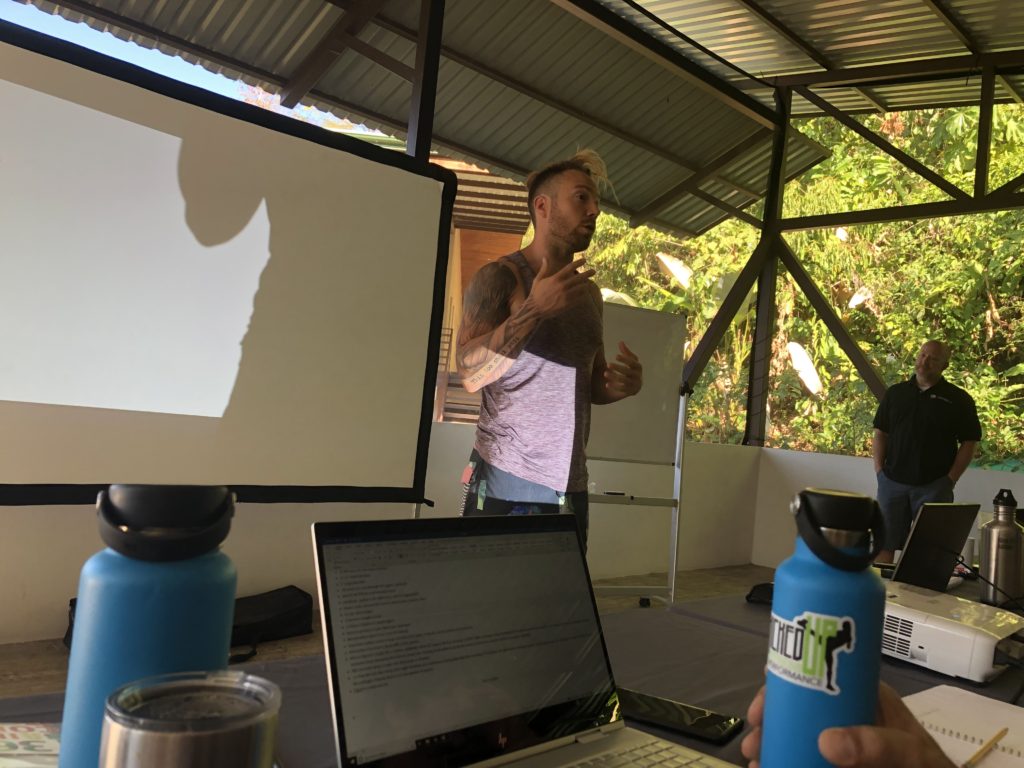
The digestive tract is where food breaks down into useful nutrients for our body. This organ system is exposed to more environment than our skin, thus keeping this system healthy is of utmost importance.
To understand how this tract is kept health, we need to normal how normal digestion occurs.
Digestion 101
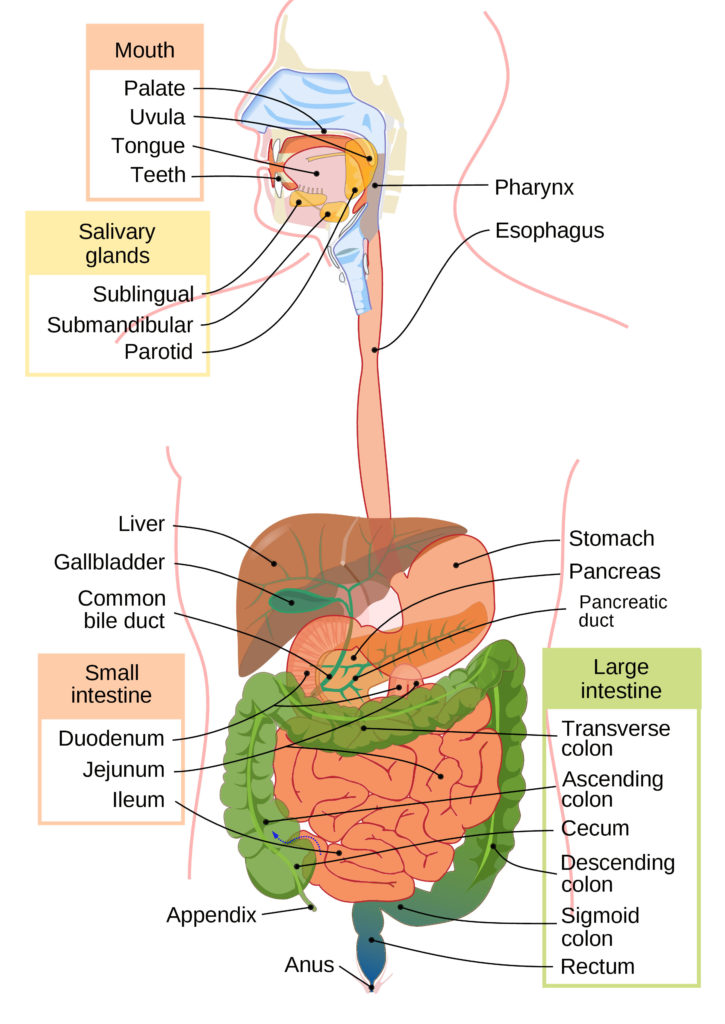
Digestion begins as soon as food enters the mouth. The enzymes lingual lipase and salivary amylase are produced to promote fat and carbohydrate digestion respectively.
The food bolus then travels down the esophagus for 2-3 seconds and into the stomach via the lower esophageal valve. This valve lets food enter the stomach while simultaneously preventing stomach acid from damaging the esophagus.
The stomach both kills pathogens and breaks down proteins. These jobs can be carried out because the of the stomach’s low pH (2.0), hydrochloric acid (HCl), B12, and intrinsic factor. The duration that food stays in the stomach depends on the mean’s total calorie count and fat content. More calories and fat equal more time in the stomach.
Once the stomach breaks down food, the remaining components exit the pyloric sphincter and enters the small intestine at a 2mL/minute rate.
The small intestine is around 15-22 feet long, and composed of three sequential areas: the duodenum, jejunum, and ileum. Between 90-95% of nutrient absorption takes place in this region and contains 103 gut bacteria per milliliter.
The pancreas, liver, and gall bladder all influence absorption in the small intestine. The gallbladder in particular aids fat absorption by sending bile into the small intestine. This substance repackages fat into chylomicrons, which are then broken down in the thoracic duct.
Food spends 6-8 hours in the small intestine before passing through the ileocecal valve into the large intestine. This digestive region is 5 feet long and absorbs nutrients from food for as long as 33-47 hours before exiting the anus.
Gut Problems
There are multiple factors that can positively or negatively influence gut health; ranging from sleep, depression, bacterial proliferation, mindfulness, hydration status, and so much more.
That said, many digestive issues boil down to altered food transit time; too fast or slow. For example, slow transit time gives gut bacteria more time to digest food.
Intestinal permeability can also be an issue. If the gut lets things out into the body that shouldn’t pass the intestinal wall, problems can ensue. Substances such as gluten, alcohol, and NSAIDs can increase intestinal permeability.
While the reasons and treatments for gut issues can be many, Ben recommends 10 key interventions to perform before a more thorough workup happens:
- Build antifragility
This category would include exercise, attaining an appropriate weight, decreasing stress, increasing muscle mass, becoming mindful, being social, improving food quality and meal hygiene, chewing, and using digestive enzymes and prokinetics
- Cognitive behavioral therapy
- Remove allergens
- FODMAP/fiber alterations
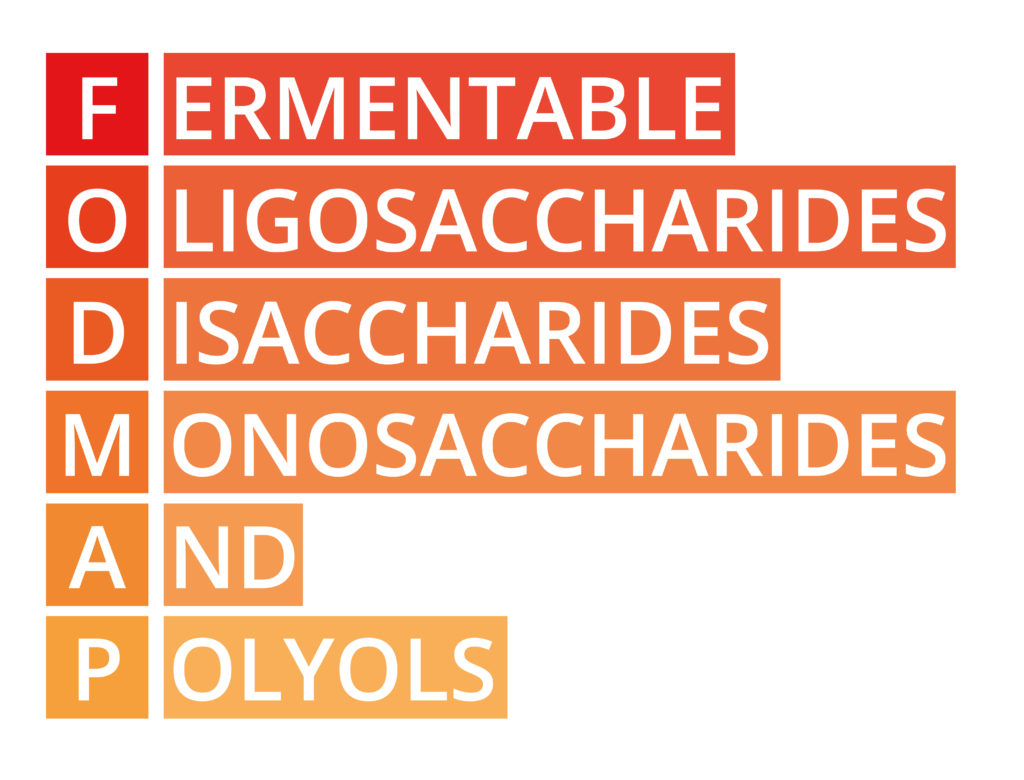
FODMAPs are carbohydrates that are poorly absorbed in the small intestine. Both cutting these out and limiting fiber to 20g can aid digestive processes. I did both of these under Ben’s guidance when I dealt with some gut issues and it worked quite well.
- Remove pathogens/repair the gut
- Time in nature
- Fasting
Fasting can be another useful method to give the gut a break. If fasting aids in gut issues, then one probably has an issue tolerating fiber. Fasting can be a double edge sword, however. If done too long, hormonal health may be negatively impacted. Ben recommends periodic 20 hour fasts, though didn’t give a frequency.
- Check thyroid
- Fecal transplant
- Probiotics
Coaching ought to play a role in guiding these behavioral changes instead of information overloading clients. Ben guides his clients by creating if, then statements to follow, and by developing contingency plans when life trouble arises. Set up successful systems for the client to be a part of.
If GI issues persist, one may consider reaching out to either or both a conventional and functional doctor. A 14 day antibiotic regimen of Rifaximin has 90% efficacy. On the functional side, a supplement such as berberine and other gut protocols have about 80% efficacy with arguably fewer side effects. Consult your doctor for more info.
All About Functional Medicine – Bryan Walsh
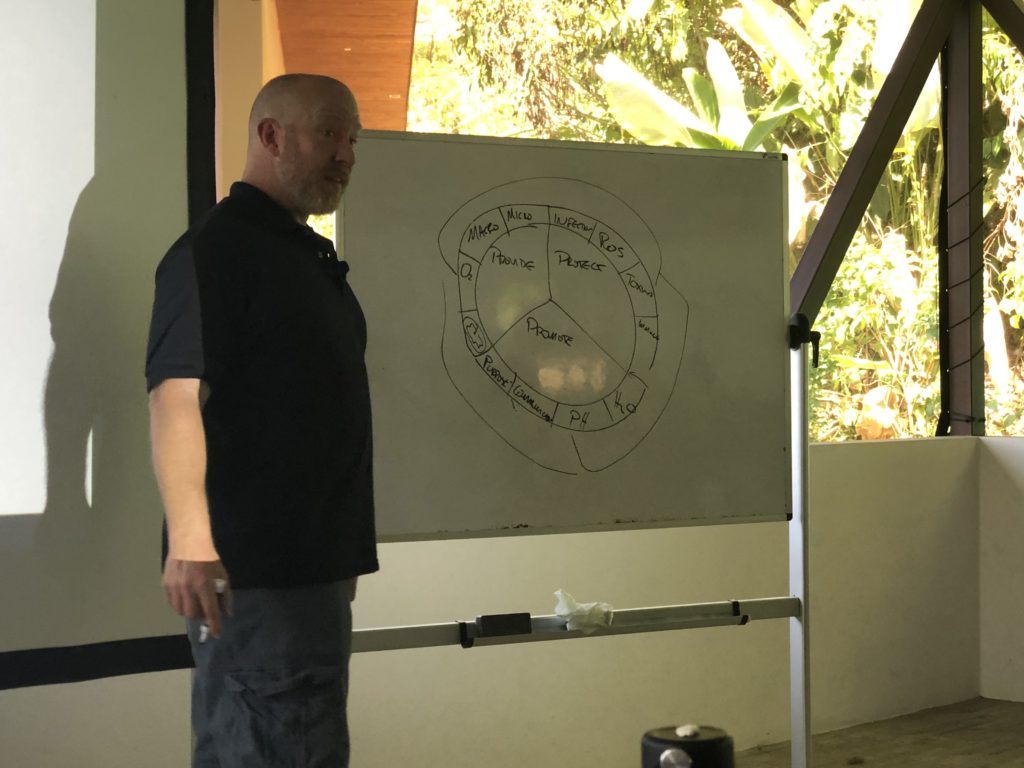
Bryan is a naturopath extraordinaire who is a master of understanding basic physiology and mechanisms. He spoke of a wide arrange of topics.
You can check out his professional page here, and his course page here.
Here were the highlights.
The Art of Thinking
We live in an age where we have more knowledge then we possibly know what do to do with. What we lack, however, is wisdom.
Wisdom is the ability to apply data and is not learned overnight. Building wisdom takes time, experience, application, thinking, reflecting, and learning from failures.
Most things in the functional medicine are stupid and wrong. Protocols fail someone at some point. Genetic testing has a 40% false positive rate. Misinformation and noise are the norm.
To navigate a sea of gimmicks, we must use reason and application. Understanding basic physiology and biochemistry can provide a beacon that allows for wise action in functional medicine.
Healthy Cells, Healthy You
On a physical level, we are composed of several different structures. Atoms combine to form molecules, which form macromolecules, then organelles, then cells, then tissues, then organs, then organ systems, then organisms, which are part of a population, which make up communities.
The cell is the first structure that can sustain life, which arguably makes the cell the most fundamental and important. Understanding how cells work and stay healthy ought to improve all of the structures that cells compose.
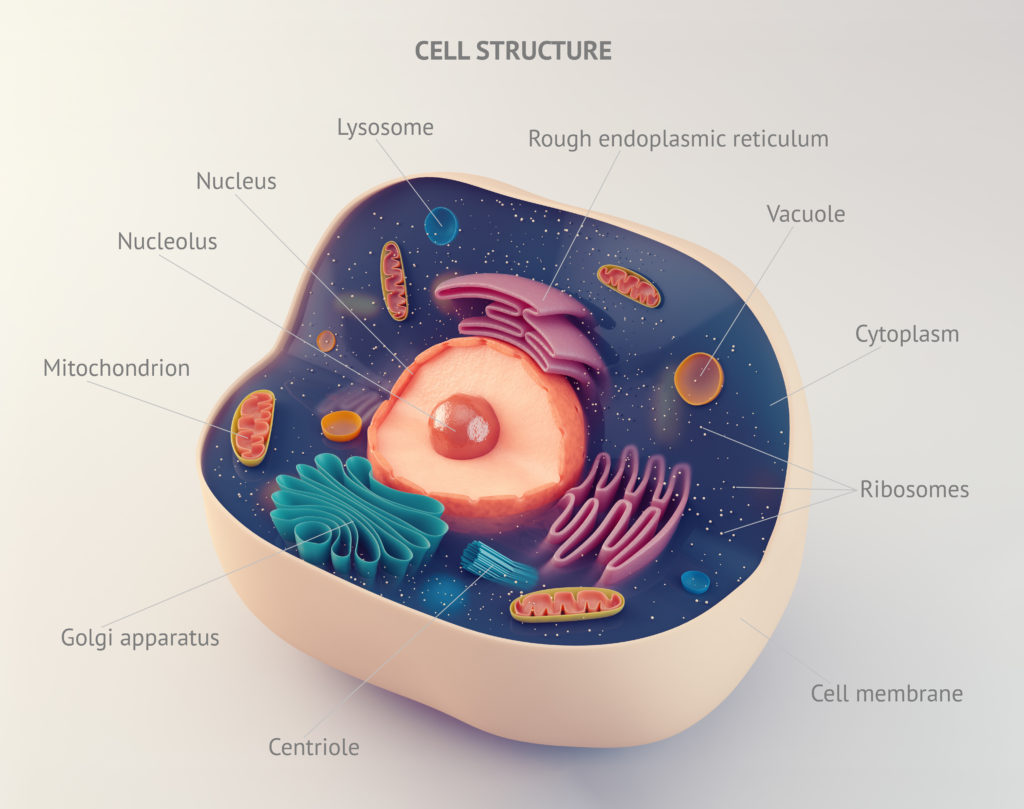
If dysfunctional cells are the root of our body issues, then healthy cells ought to fix these issues.
In order to have healthy cells, they must be provided nutrition and energy, protected from damage, and promote a healthy cellular environment. Let’s break down each of these components.
Provide
Cells need energy to function. It’s what lets cells do what they do. Thus, in order for a cell to be a cell, it needs the following components:
- Functioning organelles
- Oxygen
- Macronutrients
- Micronutrients
The VIP of these components are micronutrients. These molecules increase cellular pathway efficiency, and if deficient, will cause cells to stop working.
What makes micronutrients so important is that we cannot intrinsically produce these molecules. Oxygen deficits are rare, and the body can break itself down to obtain macronutrients, but micronutrients must come from our food.
Protect
The cellular structure must be protected from damage. There are several things that can damage the cell:
- Infection
- Reactive species (oxygen or nitrogen)
- Toxins
- Immune cells
Promote
These things promote a healthy environment for the cell:
- Purpose (cancerous cells have no purpose)
- Communication between cells
- pH
- Water
Explain Mitochondria
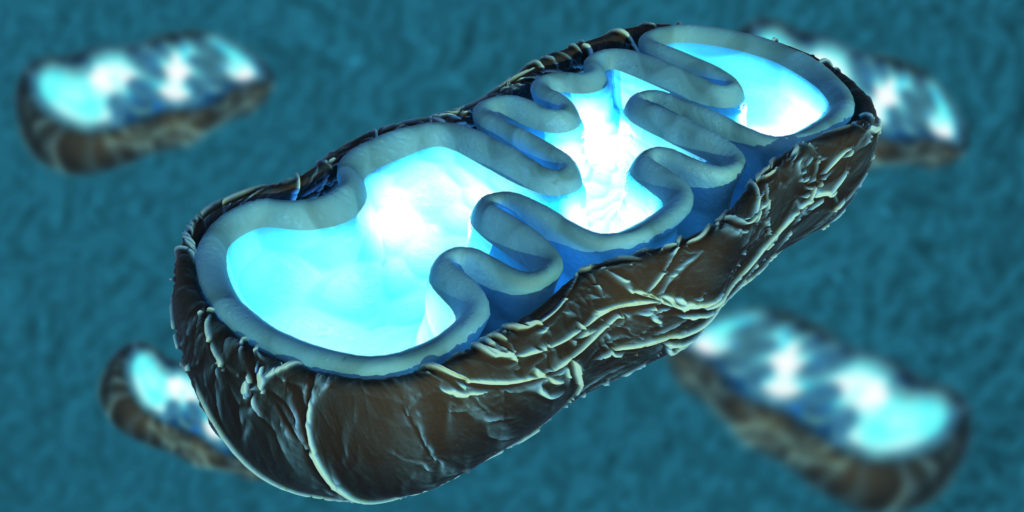
Mitochondria are organelles within the cell that play a role in several different body processes.
One of the mitochondria’s primary actions occurs through the Citric acid cycle (or Krebs Cycle), in which the mitochondria make electrons needed for the electron transport chain, thus allowing the cell to function properly. This cycle occurs when the pyruvate made in glycolysis converts to acetyl CoA. From here, the citric acid cycle can be seen in the below picture:
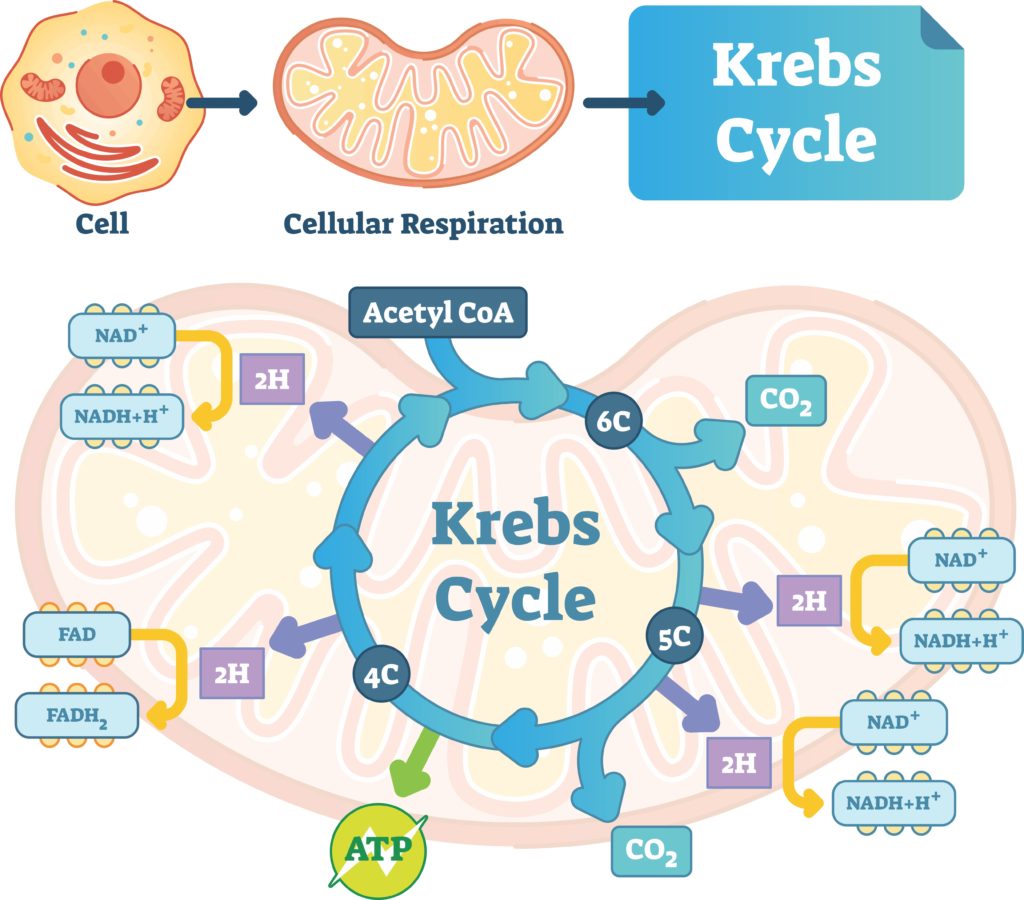
What is not shown in this cycle is all the micronutrients necessary for this process to work:
- Vitamin B1
- Lipoic acid
- Coenzyme A
- Vitamin B2
- Vitamin B3
- Manganese
- Iron
- Copper
Thus, micronutrient deficiencies can contribute to mitochondrial dysfunction. Unhealthy mitochondria can begin producing oxide radicals, which can damage cells in the process.
Mitochondrial Biogenesis
The body doesn’t make new mitochondria. Instead, mitochondria are altered via a combination of these processes:
- Fusion – Combining two halves of healthy mitochondria parts
- Mitophagy – Mitochondrial breakdown
- Fission – Separating mitochondria in health and unhealthy parts
Mitochondrial Health
Because the mitochondria can often become unhealthy for various reasons (side note, 35% of pharmaceuticals are mitotoxic), mitochondrial support protocols are rarely warranted. Instead, unhealthy mitochondria must first be cleaved off via mitophagy. We can stimulate this process by aerobic exercise, temperature extremes (sauna or extreme cold), and calorie restriction.
Diagnosing Mitochondropathy
While mitochondrial dysfunction is a real thing, it’s incredibly difficult to diagnose, especially in the functional realm. Diagnosis is often based off of symptom clusters.
Areas with either several or few mitochondria are often impacted in these conditions. For example, the heart has the largest mitochondrial density, as 42% of the heart is mitochondria. The brain, on the other hand, is 5.38% mitochondria. This low amount means that mitochondria have to work harder to keep neurological systems working, and damage to their small number can lead to many issues. Thus, cardiac and neurological symptoms are often hallmark signs of mitochondropathy.
Given that diagnostic capabilities are poor, the safe bet is likely to promote mitophagy early on with the modalities stated previously: aerobic exercise, temperature extremes, and calorie restriction.
Once mitophagy has been promoted for long enough, then it may be warranted to stimulate mitogenesis through fusion. This action can be improved by increasing PGC-1Alpha production via many different processes:
- Mitochondrial support supplements (creatine, carnitine)
- Diets (calorie restriction, fasting mimicking, time-restricted feeding, low carb, short term keto)
- Exercise
- Lifestyle interventions
- Therapeutic uncoupling
- Hypoxia
- Therapeutic mitophagy
An Antioxidant Diss Track
Bryan wasn’t big on antioxidant supplementations. Most antioxidants are actually prooxidants that stimulate our natural antioxidant system, which acts during the following instances: phase 3 of detoxification, increased glutathione production, and increased presence of NADH and NADPH.
Antioxidants are nonenzymatic in nature, which puts them at a significant disadvantage for free radical clearance. Enzymes work up to 100 times faster than nonenzymes, making it highly unlikely that antioxidants will interact with free radicals. Speed is king. The only two that have potential in this regard are vitamin E and CoQ10.
Measuring Oxidative Stress
Most oxidative stress tests do not measure what they intend to. However, there are three simple blood chemistry markers that can glean insight into if the body is struggling with oxidative stress:
Bilirubin
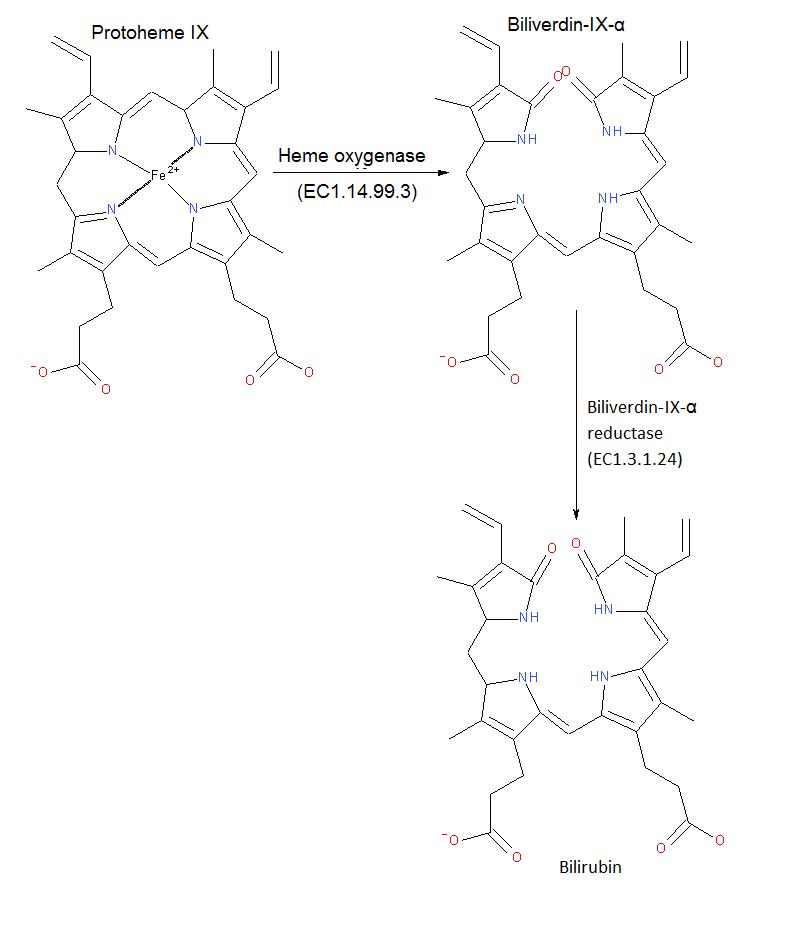
Bilirubin measures red blood cell (RBC) breakdown rate in the spleen.
Bilirubin forms when hemoglobin breaks down into heme and globin. By way of heme oxygenase, heme separates into iron and biliverdin.
When biliverdin interacts with biliverdin reductase, bilirubin forms. This molecule is a fat-soluble antioxidant which gives bile its green color. Bilirubin protects against lipid peroxidation, the degradation of lipids.
When oxidative stress occurs, bilirubin will give up an electron and turn into biliverdin. Consequently, bilirubin’s blood concentration will be low.
Though the normal lab range is 0.0-0.4, research shows that anything less than 0.4 has been associated with an increased all cause mortality. Athletes could be as high as 1.7 for this marker, thus, values lower than 1.7 may signify oxidative stress.
Uric Acid
Uric acid is the most abundant extracellular antioxidant in the body, yet is a prooxidant when intracellular.
High uric acid will be produced to combat oxidative stress. If uric acid concentrations are low, then the body is losing the fight to oxidative stress.
As a side note, molybdenum deficiency can decrease uric acid production. A quick subjective indicator of molybdenum deficiency is if the client has a sensitivity to smells.
Gamma-glutamyl transpeptidase aka GGT
This measure is related to glutathione and toxin exposure. High values indicate liver glutathione deficiency or toxin exposure.
Hydration
Cellular hydration comes down to osmolarity—the amount of “stuff” dissolved in water. Osmolarity is increased if the ratio of solute (that which is dissolved in water) to solvent (water) is high (aka concentrated), and osmolarity is decreased if the solute to solvent ratio is low (aka dilute).
While we can’t necessarily measure cellular osmolarity, blood osmolarity can provide an indirect measure due to the properties of water.
The body does not like gradients, which means that water will always flow from areas of high concentration to low concentration. If blood osmolarity drops, it will pull water from the interstitial fluid, which will then pull water from the cell; dehydrating the cell in the process.
Aldosterone, a steroid hormone and mineralocorticoid, is intimately related to how much water is in the body. When extracellular potassium concentrations increase, aldosterone is released to aid extracellular sodium resorption. Water follows where sodium goes. Thus, increased sodium resorption begets water retention.
However, in cases where aldosterone is decreased (such as adrenal insufficiency), sodium and water will get excreted, and the body will resorb potassium. Therefore, an aldosterone issue can create cellular dehydration secondary to an inability to retain water. In this case, even if you are drinking plenty of water, your cells can still be dehydrated.
Dehydration can really only be determined by electrolyte lab values. Skin turgor test is not a useful way to measure dehydration, as skin properties change with age. You can can also look at a few other measures:
Albumin
High albumin has a near-100% likelihood that you are dehydrated. Low albumin can signify inflammation or liver issues.
Normal albumin does not necessarily mean dehydration isn’t present. If one is simultaneously inflamed and dehydrated, albumin could be in the normal range, which is why you must look at other measures to confirm.
Urine specific gravity (SG)
This measure looks at urine osmolarity, which shows the dehydration mechanism present. Low SG signifies reduced water retention, whereas high SG shows lack of water period. This measure cannot inform if someone is dehydrated, just how.
Blood Viscosity
This measure looks at how thick blood is. The thicker the blood, the more friction blood will have against blood vessels, causing dysfunction. Per research, blood viscosity may be a causal, yes causal, factor of type two diabetes.
pH Explained
pH measures hydrogen ion (H+) concentration within the body, which alters the relative acid-base concentration of the system.
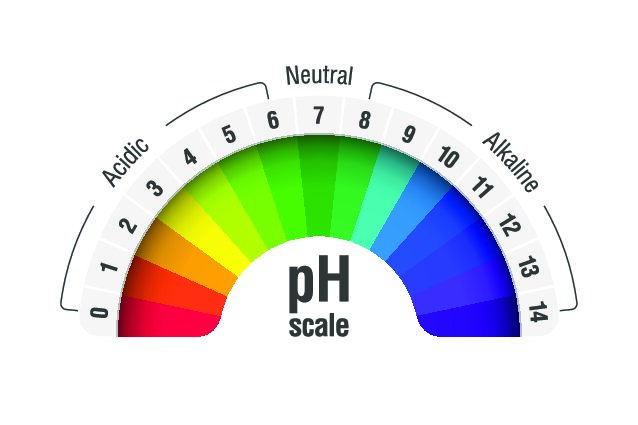
If the pH falls out of the tight homeostatic window of 7.4-7.41, enzymatic function within the body is negatively impacted, negatively impacting most all body processes.
The bicarbonate buffer system is the most common physiological pathway to manage pH.
CO2 + H20 ⇔ H2CO3 ⇔ H+ + HCO3+
This system occurs as CO2 exits the cell and enters the red blood cell. Once CO2 enters the red blood cell, it combines with water to form carbonic acid (H2CO3). This reaction occurs only if carbonic anhydrase, the fastest enzyme in the body, and zinc are present. A zinc deficiency could therefore negatively impact this mechanism.
H2CO3 is a weak acid that dissociates quickly into H+ and bicarbonate (HCO3–), the latter essentially being a masked form of CO2. HCO3– will then exit the red blood cell into the blood by exchanging a Chloride ion (Cl–), an action called the chloride shift.
The H+ produced from this reaction then binds with hemoglobin, which signals oxygen release into the cell, both keeping pH in its tight window and completing cellular respiration.
However, since CO2 is toxic in high concentrations, it must be excreted out of the body through the lungs. This occurs by the red blood cells traveling to the lungs and reversing the above reaction.
In the lungs, Cl– and HCO3–exchange once more, which then causes the bicarbonate buffer system to occur in reverse: H+ and HCO3– form into H2CO3, which then dissociates into CO2 and H2O, to which the former is exhaled out of the body.
The major advantage to transporting CO2 in this fashion is that pH is minimally altered. H+ buildup in the blood does not occur because it binds with hemoglobin. [Note, if you want to get a bit more in depth on this as I did, my source was here]
What if we have a scenario where H+ blood concentrations become so high that the bicarbonate buffer system cannot effectively clear these ions? We can then develop a condition called acidosis, where the pH dips below 7.4.
The two predominant ways acidosis occurs is either through the respiratory system or metabolic system. Since we will predominantly be talking diet, our focus will be on metabolic acidosis.
Metabolic Acidosis
If we consume too much phosphorus and protein, there is potential to develop dietary-induced metabolic acidosis, which is a risk factor for kidney stones, excessive bone resorption, decreased muscle mass, and increased chronic disease prevalence. Fortunately, eating more fruits and vegetables can offset this acid load.
So then how do we tell what direction our pH is shifting? First, let’s look at what not to test. Salivary and urinary pH measures are horrendously inaccurate, thus should be discarded.
The most accurate measure is looking at blood gases in the arteries, but this measure is highly invasive and also impractical. Thus, we need to look at proxy measures.
Venous pH is one of those proxy measures. Looking at HCO3– concentrations (CO2 on a US panel) can be that proxy. Bryan shoots for 25-28 mg/dL.
The relative acid values food produce can also be informative. The most accurate measure is the potential renal acid load (PRAL), which estimates the net acid production of your meals.
Detoxification
Yes, your body can be exposed to xenobiotics, better known as environmental toxins and pollutants. This is not a myth.

The worst of these xenobiotics are persistent organic pollutants (POPs). These toxins have an incredibly long half-life and can take years to leave the body. Many of these POPs have been found to be obesogens, and insulin resistance slows their detoxification.
Most POPs are stored in fat. Visceral fat is a less stable storage place for POPs than subcutaneous fat, which could be one reason why visceral fat is far more deleterious to the body than the subcutaneous variety. If POPs cannot stay in the visceral fat, then they may be sent to other organs, impacting their health.
Fortunately, your body has its own detoxification process that mitigates these toxins. Detoxification occurs in the liver in four distinct phases, and can be induced with moderate or heavy weight loss:
When a POP is released into the bloodstream, it is introduced into the liver (Phase 0). While in the liver, a OH– group is either added or exposed onto the pollutant (Phase I).
Once Phase I occurs, a conjugation reaction occurs to the POP. This action makes the POP water soluble, allowing for it to more readily be excreted (Phase II). The last phase involves the modified POP to enter the bilary tract into the duodenum (Phase III). Here, bile will re-circulate into the liver 14-17 times before excreting itself through the large intestine.
In order to safely induce detoxification, a combination of fat loss and detox pathway optimization. As for what goes into that, stay tuned for a future post 🙂
How to Train Your Body to use Fat and Carbohydrate for Body Composition Plus Performance – Mike T. Nelson
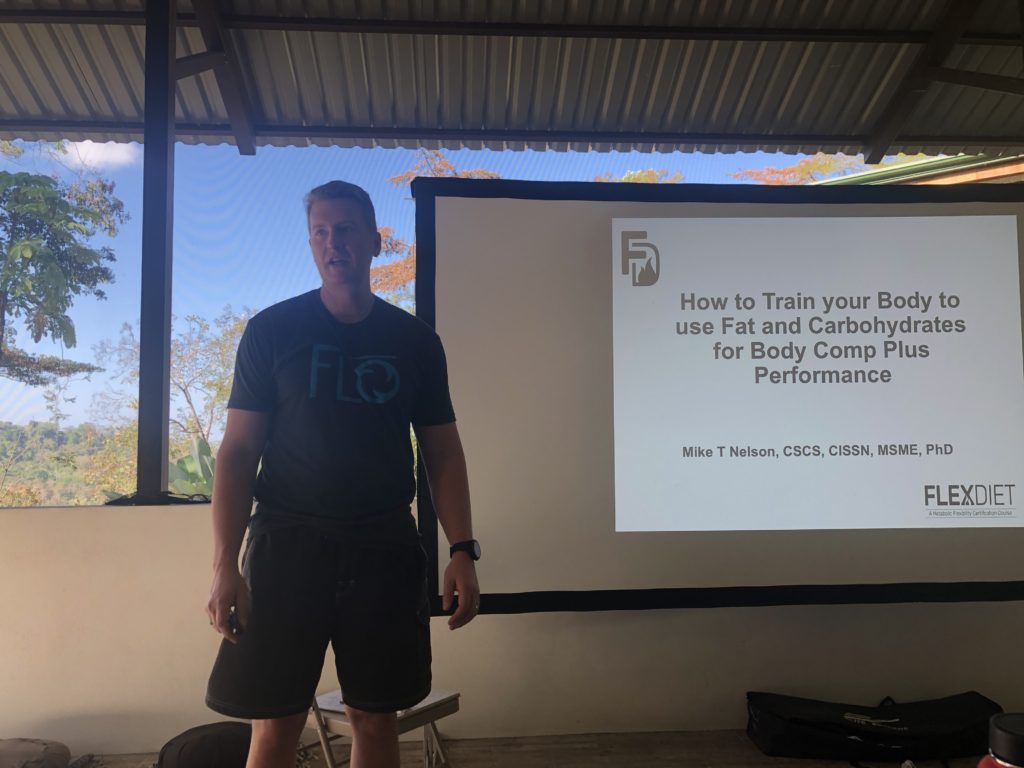
Mike T’s focused on attaining metabolic flexibility, which is the ability to shift the body’s reliance between lipids and glucose during fasting or in response to insulin (post-prandial).
Ideally, fats should be the predominant energy source at rest, and carbohydrates ought to be used at exercise.
If this flexibility is reduced, then there is impaired fat oxidation and subsequently raised triglyceride counts. High triglycerides play a role in several disease processes.
Insulin is the leverage point for metabolic flexibility. Insulin levels can impact pyruvate dehydrogenase (PDH) levels, which affects glycolysis utilization. When insulin is low, PDH is downregulated, and fat is more readily used as a fuel source. Increased insulin levels upregulate PDH, making carbohydrates more readily used.
Metabolic flexibility can be measured via lactate production during exercise. If lactate levels rise, then the person is either using fat as fuel or they’re not going hard.
Becoming Metabolically Flexible
Developing metabolic flexibility ought to occur sequentially. First, one must maximize one’s ability to utilize carbohydrates and fats separately. Once these qualities are developed, the ability to transition between nutrients with activity should be focused on.
Fasting is an easy to improve fat adaptation. A 19-24 hour fast once a week for 6-8 weeks can increase fat adaptation. Mike does not recommend doing this for super stressed individuals, however.
If a client refuses to change his or her diet, metabolic flexibility can still be induced by maximizing exercise and sleep. Fed high intensity training and fasted low intensity cardio have both been shown to improve metabolic flexibility.
Ketosis
Ketones are a byproduct of beta-oxidation to the nth degree. Its structure closely resembles carbohydrates but doesn’t replace carbs energy-wise. The fact that ketones contain calories may be useful in body composition cases in which appetite is suppressed, but is not useful for improving performance. In fact, high ketone levels have been shown to impair exercise performance.
Is the ketogenic diet worthwhile, then? Research shows that ketosis may be useful with pathologies such as traumatic brain injury, as this diet may reduce neuroinflammation.
If you go into ketosis and you feel your brain works better, this is not necessarily a good thing. This alteration may signify that your brain does not use glucose well. Therefore, pursuing metabolic flexibility may be a better alternative.
Physiological Flexibility
This section was all about hormesis, which is stressing the individual the “right” amount so favorable adaptations occur.
Hormesis is necessary for the cells in our body to become resistant to stress, ensuring their survival. If the cells are under stressed or overstressed, cellular death is likely to occur.

Hormetic stressors come in two varieties: eustress and distress.
Eustress, or beneficial stress, minimizes the stress response in an individual. For this model, we want energy substrates to match workout intensity. High intensity training should be fueled with carbohydrates, and low intensity exercise should be fueled with fat.
The distress model, higher physical strain flips the eustress model. Macros are mismatched to potentially increase adaptation.
Which stress model to choose? If plateauing happens with one plan, switch to the other.
Goals of the Gym – Ben House
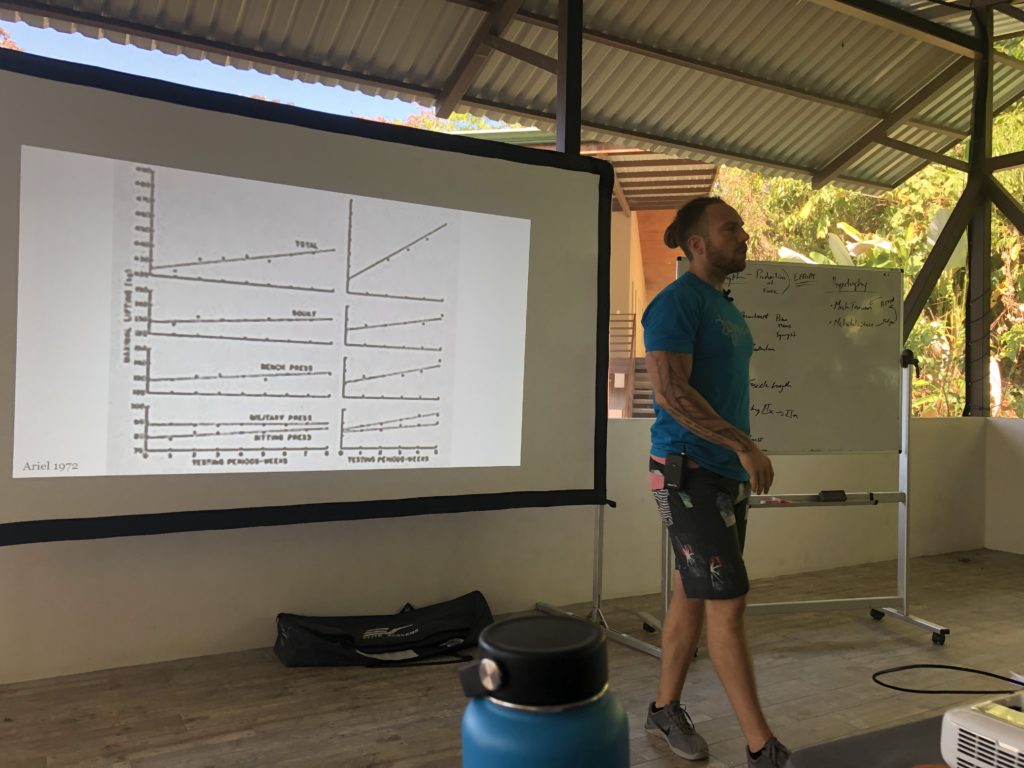
Weight room training is typically used to either build strength or hypertrophy. Strength is defined a force production by effort, where hypertrophy involves muscle growth.
How to Improve Strength
Let’s first talk about strength. In order to improve this quality, we need to favorably impact connective tissue, neural recruitment, and have local muscular changes.
Connective Tissue
Improving connecting tissue means altering tendon stiffness. This adaptation can be stimulated by working at 70% of 1-RM or greater. These changes take six months to a year to achieve.
Neural Recruitment
Neural changes are specific to load/context. One can either increase motor unit recruitment by simultaneous improvement of prime movers and synergists, and/or decrease antagonist recruitment.
Rate coding can also be improved secondary to improving rate of force development.
Local Muscular Changes
Strength can be improved by altering fascicle length through eccentric load, increasing muscle diameter, increasing available substrate for energy production, and switching fiber type from type IIx to type IIa.
Creating Muscular Hypertrophy
Next, let’s discuss hypertrophy. In order for muscle growth to occur, we must recruit as many high threshold motor units as possible. To do so, we must either create enough mechanical tension (5-rm worth) or induce metabolic stress (training to fatigue). With both stimuli, the key is maximal effort.
Despite speed training recruiting high threshold motor units, there is not enough tension or metabolic stress generated to elicit a hypertrophy response.
Other keys for hypertrophy include volume, adequate sleep and nutrition, and reducing overall stress.
Which Comes First – Strength or Hypertrophy?
Strength most likely needs to be pursued before hypertrophy. The more force one produces, the greater maximal tension can be generated. This increased tension can induce the metabolic stress necessary for hypertrophy.
Excerpts from Rethinking the Big Patterns 2.0 – Pat Davidson
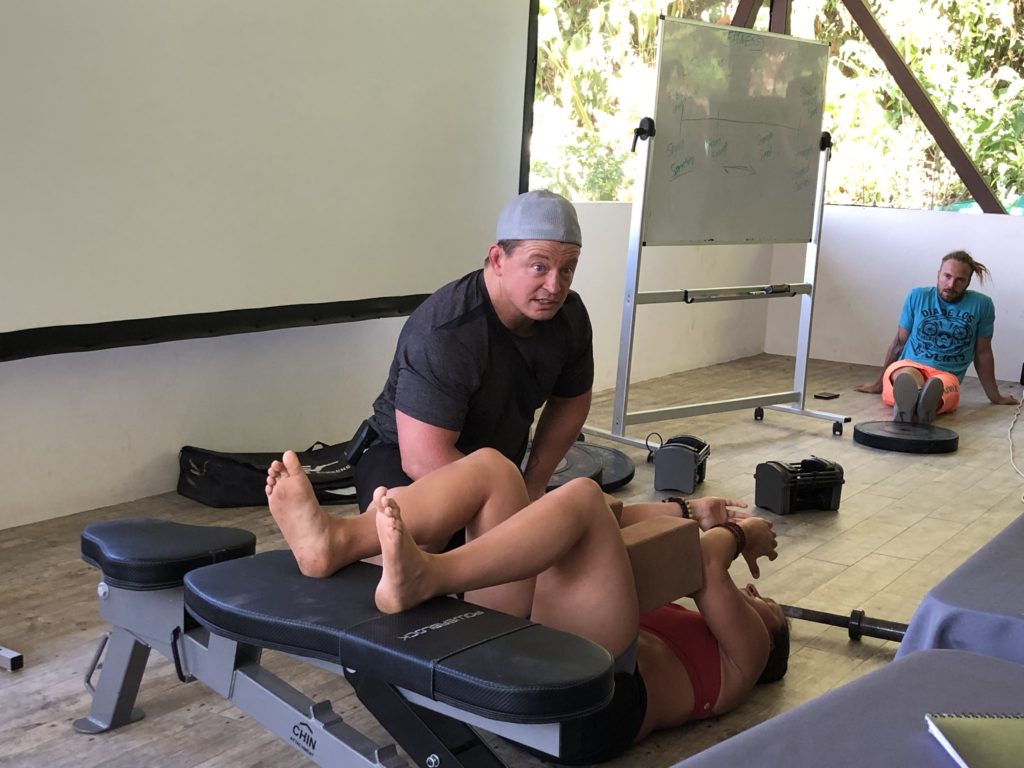
Pat Davidson updated us on his model, Rethinking the Big Patterns, and discussed all things programming and progression. Let’s get nuts.
The Goal of Training
The goal of training is to take movement that looks awful and move it as close to the archetypical movement, the standard, as possible.
These archetypical movements make up Pat’s programs, which are then manipulated based on stance, patterns, load, velocity, duration, and plane.
Lower intensity movements should be sensory rich and exploratory, as one has time to process what is occurring within his or her body.
As load and velocity increase, the sensory experience decreases. There are too many variables to process as the intensity rises. If you start sensing things at these high intensities, that is likely a warning signal or pain.
Movement can be progressed by considering the following variables:
Desirable axial/appendicular orientation → isometric of progressive duration and volume → isotonics of progressive duration and volume → increase complexity and intensity
Here are other variables to consider progressing:
- Joint complexity
- Antigravity demands
- Constraints
- References
- Load
- Range of motion
- Duration
- Frequency
- Joint complexity
The 5 Elements of Fitness
There are many purported fitness qualities, but Pat condensed them all to five. If your favorite is not on the list, blame correlation studies. If two variables correlate above 0.70, it is likely they are measuring the same quality.
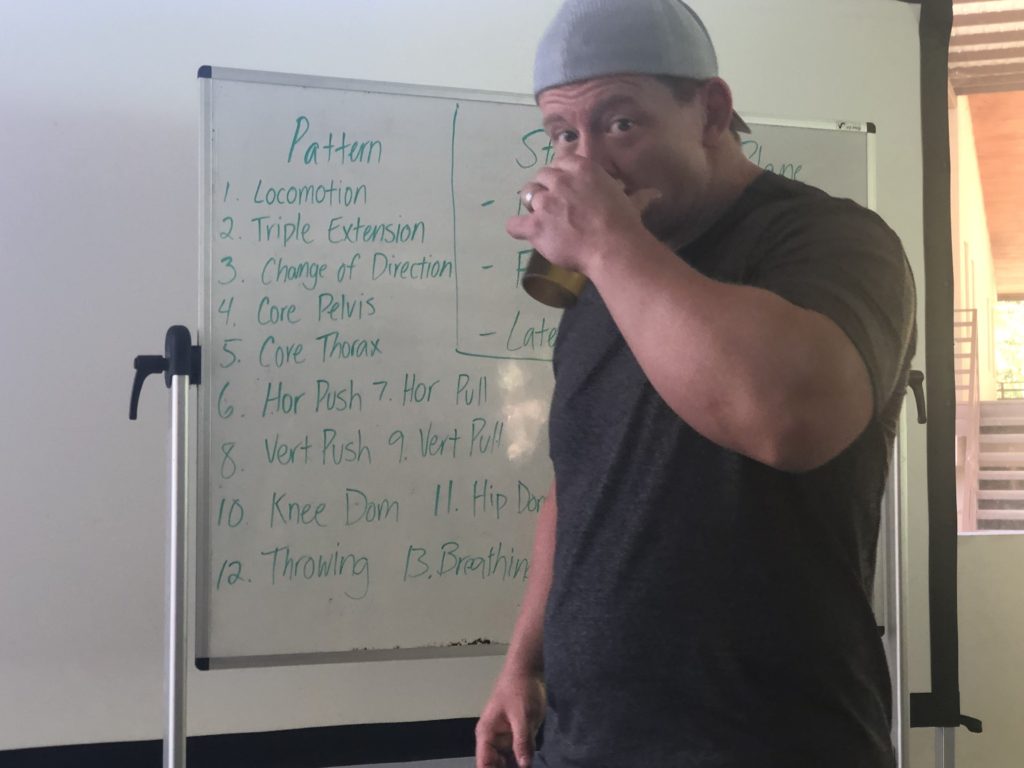
Here are Pat’s five elements:
1. Strength
Strength is the amount of force a joint is capable of producing at a given velocity
2. Cardiorespiratory Endurance
This element is how the cardiac system can sustain a given output.
3. Flexibility
Flexibility is the range of motion available at a given joint. Improvements in flexibility likely occur through increased stretch tolerance, with minimal chronic tissue effects. Puberty is what sets someone into being flexible, as that is when motor neuron myelination is complete. Any changes you see in flexibility are neurological in origin.
4. Muscular endurance
How long the muscles can produce a given output.
5. Body composition
Uh, how you look fam.
The Somatic Embedding of Threat – Seth Oberst
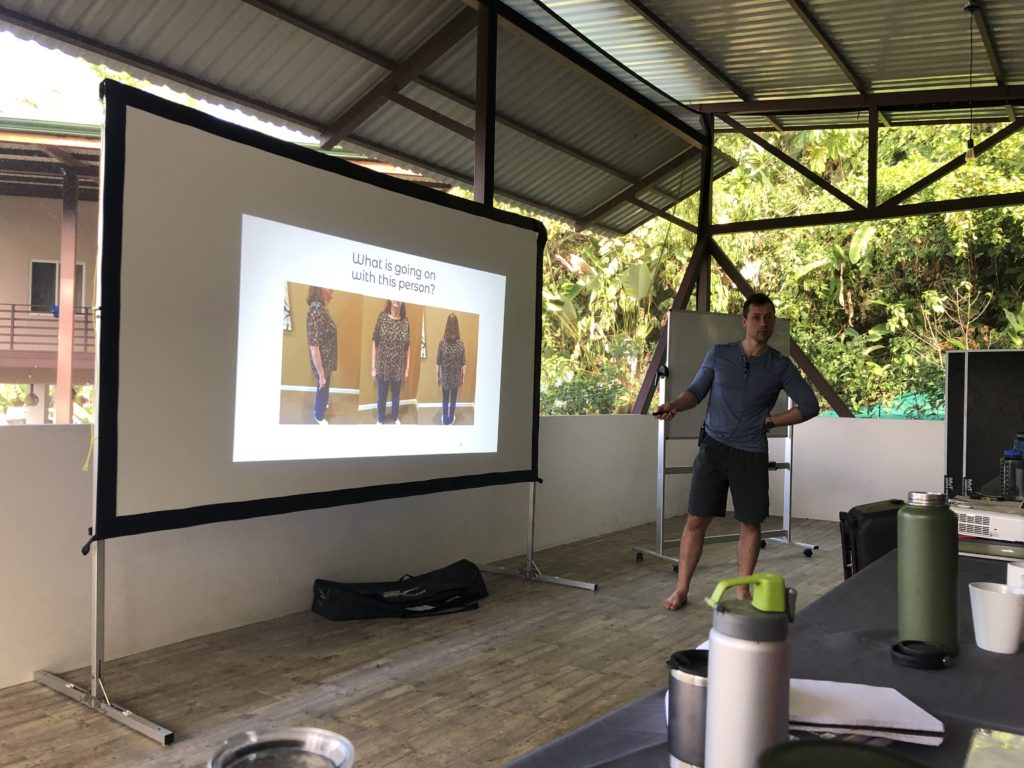
Seth’s big focus was on self-regulation, which he also dives into great detail in his course.
Self-regulation is the intrinsic ability to respond to the ongoing demands of internal and external life with an efficient range of responses. The goal would be to associate intense sensations with safety, mastery, and autonomy.
There are three things to focus on when learning self-regulation: responsivity, differentiation, and completion.
Responsivity
Responsivity is a need for accurate and timely responses to our internal needs. This area can be improved with interoception, which awareness of what’s happening in our own bodies.
Differentiation
Differentiation is the ability to discern safety vs. danger. We are biased toward danger as a protective mechanism
Completion
Completion involves a resolution towards recovery and completeness
The Keys of Self-Regulation
Much of our ability to self-regulate comes from our childhood. Someone older than us, typically parents, teaches us safety and danger. This environment both provides us a secure base to operate from and gives us a place to feel safe. Here we can experience a rich sensorimotor environment, have social connection, and receive feedback to enhance our self-regulatory responses.

Feeling safe allows us to bond effectively with others. When we perceive threat, however, we employ protective strategies and reduce social behaviors.
Two protective strategies can come into play. When threats are perceived as persistent, we can become hypervigilant. However, if resistance is futile, and our systems cannot attenuate the threat, then we will shut down, become unresponsive, or have a disorganized array of responses.
One can become either hypervigilant or unresponsive if danger is perceived, needs aren’t met, or threat attenuation is incomplete. These states are commonly obtained either from childhood or if one is hit with an intolerable and overwhelming threat.
All is not lost when we become dysregulated. Regulation can be restored by somatic support (movement) and attunement. We can attune to others by providing a healing environment, sensing change, not judging, and being present.
When does self-regulation leave the hands of a movement professional and into the hands of a psychotherapist? If there are relational or emotional issues present.
A Consistent Approach – Lucy Hendricks

Lucy, The Holistic Fitness Connector Herself, Hendricks started her talk with a tale of two clients. One, your “typical” general population client, and the other one in persistent pain.
Lucy does not discriminate these clients. Each one starts with a similar program. The same simple moves and concepts. The basics.
It is worthwhile to start clients with the basics for many reasons. One, lower level exercises have important components that are needed to be mastered in complex movements. The pieces in a 90/90 hip lift are important to carry over into a loaded squat.
These keys: exhale, reach, and tuck.
These three components are important in most any exercise we do in the gym, and are essential for setting the body up to perform at a high level.
Applying exhale, reach, and tuck to building a squat may look as follows:
90/90 hip lift→ Quadruped Breathing→ Goblet Squat→ Trap Bar Squat
Weight training is a skill like any other, and you can’t skip over the basics and expect a skill to be mastered.
Second, having the same starting point and progression allows for a consistent approach among all trainers. If the same progressions and cues are used, then the specific trainer becomes less relevant. The service remains the same, which is essential for scalability.
Memoirs of a Meathead: A Case Study – Ryan L’Ecuyer
Ryan is one of the best trainers I know, and is a great natural bodybuilder. His talk entailed the highs and lows of bodybuilding contest prep, providing many useful insights into both weight gain and loss.=
Fat loss
Fat loss occurs predominantly through calorie restriction and is important to do before a bodybuilding show.
For weight loss in untrained subjects, losing 0.7% bodyweight per week can still result in gaining lean body mass, i.e. muscle. Losing 1.4% bodyweight per week can retain lean body mass. Postmenopausal women, however, are likely to lose lean body mass with just about any weight reduction.
When calories are restricted, the body makes adjustments to reduce energy expenditure. Some changes include reduced thyroid output, heart rate, respiration, sympathetic output, and non-exercise activity thermogenesis (NEAT). Muscle efficiency is increased, however.
To counteract these adjustments, maximizing exercise and NEAT is paramount. Ambulation is a key component to NEAT, and one should shoot for 8,000-10,000 daily steps to maximize losses.

In order to preserve lean body mass, training is of utmost importance. Less complex exercises should be used to minimize structural and neural fatigue. Machines and accessory movements work great here. To keep volume high, increase training frequency. This is also not the time to introduce novel exercises or programs. Keeping the same moves will reduce muscle damage and take advantage of the repeated bout effect.
One of the hardest parts about fat loss is sticking to the program. Refeeds can be useful in this regard. Refeeds consist of one to two consecutive carb-heavy days per week, up to 500g in total. Make the week suck, then have one great day.
Refeeds are useful for increasing adherence, improving muscle protein synthesis, and decreasing hunger. Acute performance will be improved, and fat free mass will be better retained. You’ll also increase leptin hormone amount, the satiety hormone.
Diet breaks can also be useful for improving adherence. According to the MATADOR study, alternating two weeks of cutting and weight maintenance for a 30-week totals led to greater body fat lost and lean body mass retention versus a straight 16 week cut. Diet breaks attenuate metabolic adaptation, increase leptin, improve performance, and provide a needed psychological break. The only downside is the diet duration is longer.
Early in one’s career, you can cut fat quickly and lose lean body mass because it’s easier to put on. Later in one’s career, preserving lean body mass is essential, thus long duration cuts are a better choice, such as the style above.
Other things that change during a cut:
- Liver enzymes initially decrease, after a show and refeed they hugely increase
- Thyroid decreases with restriction, then increases with weight gain.
- Testosterone decreases – reduced spontaneous and strength of erections; increased aggression; reduced sex drive
- GI distress – reduced bowel movement
- TO fix – use coffee, Motilpro, Magnesium, appropriate amounts of fiber; and reduce FODMAPs while dieting.
- Sleep becomes disturbed – there is a reduction of quantity and quality; start dreaming about food; can fix by backloading calories before bed.
Regaining Weight
The goal of gaining weight is to feel good again, like a normal person. There are several negatives that happen during the re-gain however:
- Increased abdominal fat during immediate weight gain, likely to protect the organs and increase core temperature
- Increase food efficiency
- Increase adipocyte number and supercompensation for adipose tissue
- Decreased test levels if during recovery you gain weight fast
To mitigate these negative effects as best as possible, increase calories slowly. You will likely feel fat on the way up.
Implications of Repeated Weight Loss
Yo-yo dieters tend to be more overweight in the long run, as each successive weight loss increases how efficient you are with food. The worst thing you could do as a person is diet.
To smoothly transition in size, shift your focus. Stop looking in the mirror, focus on performance, and enjoy your life.
Don’t diet until everything is back to normal, you are sick of eating, and wait 3-5 years between shows if you are competing in bodybuilding.
Sum Up
As you can see, this retreat was absolutely stacked with great minds to learn from. If you haven’t attended the Beginner’s MInd, you are beyond missing out.
To summarize:
- To keep your gut healthy, you must train, eat well, connect with others, manage stress, and sleep
- Cells are the fundamental component of life. Keeping cells healthy keeps us healthy
- We must become metabolically flexible, which entails using nutritional substrates for their intended activity
- The goal of training is to get as close to the archetypical movement as possible
- Movement and attunement to self and others can restore self-regulation
- Training is a skill, and you must master the basics before moving onto advanced activities
- Fat loss and muscle gain have consequences
What was your big a-ha moment in this post? Comment below and let the fam know!
